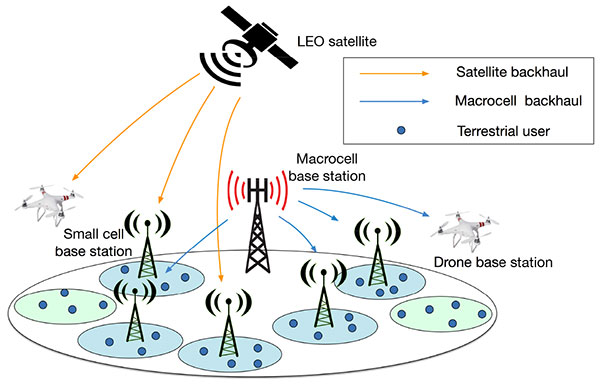
Constellations recently sat down with Bill Ray, Vice President Analyst for Gartner Research and part of Gartner’s emerging technologies and trends office. Gartner is one of the world’s largest and most respected technological research and consulting firms. The discussion covered a broad range of topics including LEO constellations, 5G technology, the emergence of global connectivity and investment strategy. While the topics were varied, the common thread among them was that they are all evolving and feeding each other. Some are evolving due to technology advances, market opportunities and available capital while others evolve to fulfill as of yet unfulfilled expectations. Ray points to 5G as an example of the latter.
Ray explained how the world was primed to expect ubiquitous coverage, connectivity to a lot of low power sensors to the internet of things (IoT) and very high bandwidth when 5G arrived. While 5G does provide high bandwidth (where coverage is available) ubiquitous coverage and low powered connectivity for IOT are still evolving.
Two limiting factors are responsible. First, is that the 5G radio standard was not designed for low power connectivity. It was designed for lots of streaming video and holographic displays. It’s strength is in video streaming, not the type of low power we associate with the IOT. Second, the use of millimeter wave frequencies and the higher bands means that the range is significantly lower than previous technology, such as 4G or 3G, and therefore you need more base stations than anticipated.
 Low earth orbit satellites can immediately, and cheaply, deploy base stations making 5G available to the remotes of areas
Low earth orbit satellites can immediately, and cheaply, deploy base stations making 5G available to the remotes of areas
Wither 5G?
Ray compared 5G coverage to that of satellite networks, many of which offer global coverage. Coverage claims initially anticipated from 5G are, in reality, being delivered by satellite, he said. Bottom line is that 5G is not yet delivering any differential or improved experience.
But all is not lost, according to Ray. While it hasn’t been the revolution it was predicted to be, there is a near term contributary role for 5G: coverage in remote areas. When you look at Sub-Saharan Africa, India or even rural Wyoming, for example, there is little to no coverage. But by providing back haul capability, low earth orbit satellites can immediately, and cheaply, deploy base stations, which will increase coverage and make 5G available much more quickly.
“If you can get coverage everywhere,” he went on, “if I can take out my phone and get 5G in the middle of the desert, in the middle of a city or anywhere, that really changes things and 5G itself will be very important.”
Expanding on 5G, Ray discussed the need for speed, the idea that everything has to be faster. As he sees it: “The very concept of enough speed doesn’t really seem to occur to the telecommunications industry. Once you get above 50 or 60 megabits per second, you can’t do anything with it. And while you can technically, get a gigabit per second to a 5G mobile phone, it’s of little value if you can’t display more video. If holographic displays, smart glasses and self-driving cars become mainstream, then you can start to use that kind of bandwidth. As Ray sees it today, it is much better to have 10 megabits per second that always works than a gigabit per second that sometimes works.
LEO – Changing the Way We Work
While 5G has not yet lived up to its advanced billing, the LEO constellation market has, in many ways exceeded its early expectations, driven in part by launch technology, phased array, or self-configuring antennas and significant government and private investment. While phased array antennas have some disadvantages compared to dish antenna i.e.: limited scanning range, low frequency agility and a complex structure, the fact that you can just take them out, sit them on a flat surface and then instantly log onto the satellite is a big plus. Additionally, they are getting and will continue to get cheaper, but, according to Ray, the simplicity of operation has been the key factor.
 Gartner sees LEO satellite backhaul accelerating 5G availability
Gartner sees LEO satellite backhaul accelerating 5G availability
Investment Drifting to Services
As the technology evolves, so too does space investment strategy, which continues to grow…but in different directions. Rather than investment being concentrated in satellite and launch technology, it is becoming more focused on industry verticals. Investment is drifting to the companies that analyze and exploit the data, much to the benefit of their clients and shifting away from hardware and towards services that extract value from space.
Agriculture is a prime example where the ability to see and analyze wide crop fields during the planting and growing phases has led to savings on seeds, water, pesticides and fertilizer. Similar benefits are seen in other industries as well such as mining and environmental issues. Companies are investing in those verticals rather than investing in satellites or investing in launch vehicles.
Gartner believes that the real “killer” app will be asset tracking – being able to know where everything is, railway carriages, generators or combine harvesters all over the U.S. The ability to manage your assets, to be able to move them where needed can really enhance efficiency.
Lunar – The Next Frontier?
While 60% to 70% of space company funding was directed at LEO endeavors there has been an uptick in lunar investment, primarily at the government level. As Ray describes Gartner’s view on lunar investment: “We don’t do space for fun, lovely as it is. there has to be a revenue opportunity.”
Part of that opportunity could revolve around lunar mining. According to Ray, there are several materials that could be mined on the moon, especially Helium-3, a rare isotope on Earth, but abundant on the Moon. It has been proposed as a power source for long range space flight because of its lunar abundance. “But we are not there yet,” he acknowledged. “We need to do more research and governments have to pay for that because companies can’t take that long term investment.”
Ray noted that there is one downside to being able to track your assets, analyze the terrain for agriculture, mining or the environment…or to track your competitors: You’re going to have to start thinking about how to conceal information about your own business. “There’s going to come a time when your competitors can see what your business is doing. And you might want to conceal that,” Ray concluded.
